 | Tuesday, May 4, 2004 |
|
Tuesday, May 4 3:30 p.m. DIRECTOR'S COFFEE BREAK - 2nd Flr X-Over 4:00 p.m. Accelerator Physics and Technology Seminar - 1 West Speaker: S.G. Tantawi, Stanford Linear Accelerator Center Title: Multimoded RF Systems for X-Band Future Linear Colliders
Wednesday, May 5 |
|
Wilson Hall Cafe Tuesday, May 4 Golden Broccoli & Cheese soup Hickory Smoked BBQ Pork $4.75 Japanese Breaded Pork Cutlet $3.75 Hawaiian Marinated Chicken w/Grilled Pineapple $3.75 Toasted Almond Chicken Salad on Low Carb Bread $4.75 Portabella Mushroom Baked Pizza Wrap Chicken Fajita Tacos $4.75 Wilson Hall Cafe Menu Chez Leon |
|
Extended Forecast |
Secon Level 3 |
| Fermilab Today is online at: http://www.fnal.gov/today/ Send comments and suggestions to today@fnal.gov Fermilab Today archive Fermilab Today classifieds Subscribe/Unsubscribe to |
|
First Data From Deep Underground Experiment Narrow Search for Dark Matter | ||
| ||
|
With the first data from their underground observatory in Northern Minnesota,
scientists of the Cryogenic Dark Matter Search have peered with greater
sensitivity than ever before into the suspected realm of the WIMPS. The sighting
of Weakly Interacting Massive Particles could solve the double mystery of dark
matter on the cosmic scale and of supersymmetry on the subatomic scale.
The CDMS II result, described in a paper submitted to Physical Review Letters,
shows with 90 percent certainty that the interaction rate of a WIMP with
mass 60 GeV must be less than 4 x 10-43 cm2 or about
one interaction every 25 days per kilogram of germanium, the material in
the experiment's detector. This result tells researchers more than they
have ever known before about WIMPS, if they exist. The measurements from
the CDMS II detectors are at least four times more sensitive than the best
previous measurement offered by the EDELWEISS experiment, an underground
European experiment near Grenoble, France.
|
|
New Way to Request Visitor Passes | ||
| ||
|
The Lab has a new web based system for requesting visitor passes.
The Site Access Visitor Request form is available online or go to the
ES&H Section Home Page > Security > Site Access Visitor Request Form, and
simply follow the directions.
As before, only employees and users have the authority to grant site access to a visitor. The requestor needs to provide the purpose of the visit, the expected arrival date and time, the duration of visit, and the names and affiliations of the visitors. Once the visitor request data is properly logged, the guards in the Lederman Science Center Guard House need only verify the identity of a visitor, and then print their visitor passes. As the passes are handed out, a bar-code on the passes is scanned by the guard. This serves to document that the visitor has arrived and, if the requestor wishes, an e-mail is sent announcing their arrival.
This new computer-based approach is less labor intensive
than the previous procedure. It is
less prone to errors and provides greater functionality.
The new plastic passes also make better souvenirs than the
old-style paper passes, not to mention that they can be recycled.
For those without internet access, or for the automation-challenged,
Dispatch will still accept requests at x3414.
|
Good Morning!
A group of university faculty members wrote me a thoughtful letter recently pointing out the particular value of the LHC Physics Center to groups that are part of the CMS collaboration in addition to either CDF or DZero. These groups will be able to share people across the two research programs more efficiently because of the LPC. This sharing will also ensure that physicists bring important experience from the Tevatron to the LHC research program.
As a result of what we are doing now, the LHC Physics Center will be an
important institution at Fermilab for decades to come.
|
|
April 30 - May 3 - Operations established two stores that along with an existing store provided 62 hours and 55 minutes of luminosity to the experiments. - The Meson MTest experiment takes fast spill - The Antiproton Source had emittance, timing, and stacking problems
View the current accelerator update |
|
From the Chicago Tribune, May 2, 2004: DR. ARTHUR ROBERTS, 91 University of Chicago physicist, music fan By Imran Vittachi As he did throughout much of his life, Dr. Arthur Roberts played air piano the day he died, his fingers dancing over an imaginary keyboard. He was a nuclear physicist who fused science with his love of music.
Dr. Roberts, 91, whose work in physics took him to the University of
Chicago physics department and the University of Chicago-run Argonne
National and Fermi National Accelerator Laboratories, died of
Alzheimer's disease Thursday, April 22, at his home in Honolulu.
Dr. Roberts moved to Hawaii in the late 1970s.
|
|
Sitewide Emergency Warning System Testing Today The Sitewide Emergency Warning System is scheduled for testing today at 10:00 a.m. All components and voice interfaces for CDF, DZero, FCC and Wilson Hall will be tested. The test will begin and end with the announcement, "This is a test of the sitewide emergency warning system." Any questions or problems should be reported to Bill James at x8901.
Upcoming Classes
Memorial Ceremony for Carmenita Moore
FNPRT Printserver Scheduled Downtime |


